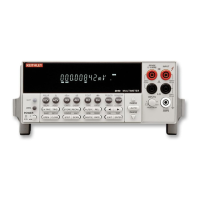For a description of the other bits in the Status Byte Register, see “Common commands”.
The IEEE-488.2 standard uses the *STB? common query command to read the Status Byte
Register.
When reading the Status Byte Register using the *STB? command, bit B6 is called the MSS
bit. None of the bits in the Status Byte Register are cleared when using the *STB? command to
read it.
The IEEE-488.1 standard has a serial poll sequence that also reads the Status Byte Register
and is better suited to detect a service request (SRQ). When using the serial poll, bit B6 is called
the RQS bit. Serial polling causes bit B6 (RQS) to reset. Serial polling is discussed in more detail
later in this section.
Any of the following operations clear all bits of the Status Byte Register:
• Cycling power.
• Sending the *CLS common command
NOTE The MAV bit may or may not be cleared.
Service request enable register
This register is programmed by you and serves as a mask for the Status Summary Message
bits (B0, B2, B3, B4, B5, and B7) of the Status Byte Register. When masked, a set summary bit
in the Status Byte Register cannot set bit B6 (MSS/RQS) of the Status Byte Register.
Conversely, when unmasked, a set summary bit in the Status Byte Register sets bit B6.
A Status Summary Message bit in the Status Byte Register is masked when the corresponding
bit in the Service Request Enable Register is cleared (0). When the masked summary bit in the
Status Byte Register sets, it is ANDed with the corresponding cleared bit in the Service Request
Enable Register. The logic “1” output of the AND gate is applied to the input of the OR gate and,
thus, sets the MSS/RQS bit in the Status Byte Register.
The individual bits of the Service Request Enable Register can be set or cleared by using the
*SRE <NRf> common command.
To read the Service Request Enable Register, use the *SRE? query command. The Service
Request Enable Register clears when power is cycled or a parameter (n) value of zero is sent
with the *SRE command (*SRE 0).
4-22 Remote Operation

